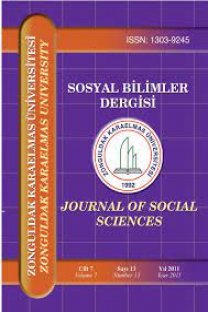The useage of Z-score model as bankruptycy prediction modeland an aplication to companies of Kazakhstan
Şirketlerin iflası, geniş araştırmalara konu olmuştur. 1960‟lı yıllardan bu yana bir takım modeller, başarısızlıkların tahmin edilmesi amacıyla geliştirilmiştir. Bunlardan Dr. Edward Altman tarafından, 1968 yılında Amerikalı şirketler için geliştirilen Z-score modeli, en çok pratikte kullanılan model olmuĢtur. Bu modelde, şirkete ait bir grup finansal oranın analizleri yapılmak suretiyle, şirketin iflas etme ihtimali hesaplanmaya çalışılmıştır. Bu çalışmada, Kazakistanda Altman‟ın tahmin modelinin ne kadar verimli kullanılabileceği araştırılacaktır. Modelde kullanılan finansal veriler Kazakistan Menkul kıymetler Borsasına kayıtlı şirketlerin finansal tablolarından elde edilmiştir.
Z-score modelinin iflas tahmin metodu olarak kullanımı ve Kazakistan şirketlerine yönelik bir uygulama
Corporate bankruptcy is a subject of extensive research, and since 1960‟s a number of models were developed to predict failures in the real world. The most prominent research was done by Dr. Edward Altman, who developed Z-score model in 1968 for the US companies, which has been extensively used by practitioners. In this model a set of financial ratios specific to a company are analyzed in order to give a judgment on the company‟s likelihood to go bankrupt. The goal of this paper is to see the efficiency of Altman‟s bankruptcy prediction model to Kazakhstan market. The model is built based on financial variables which are derived from financial statements of companies listed on Kazakhstan Stock Exchange (KASE).
___
- Altey, Aidarkhan(2009), Assessing the Probability of Bankruptcy: Application of Altman's Z-Score Model to Kazakhstani Markets, Unpublished MBA Thesis, Scientific Coordinator, Professor, Ph.D., Osman Shahin, Süleyman Demirel University, Kazakhstan.
- Altman, E. I. (1968), "Financial Ratios, Discriminant Analysis and the Prediction of Corporate Bankruptcy", Journal of Finance, September, pp.589-609.
- Altman, E.I., J. Hatzell and M. Peck (1997), Emerging Market Corporate Bonds: A Scoring System, New York: Salomon Brothers. Reprinted in Emerging Market Capital Flows, edited by R. Levich, Amsterdam: Kluwer Publishing.
- Altman, E. I. and A. Saunders (1998), "Credit Risk Measurement: Developments Over the Last 20 Years", Journal of Banking and Finance 21, pp.1721-1748.
- Beaver, W.H. (1997), "Financial Rations as Predictors of Failure", Empirical Research in Accouting:Selected Studies, 1996, Supplement to vol. 4. Journal of Accounting Research, pp.71 -111.
- Caouette, J.B., Altman, E.I. and Narayanan, P. (1998), Managing Credit Risk, John Wiley & Sons. International Rights Inc.
- Chorafas, D.N. and Steinman, H. (1991), Expert system Banking: A Guide for Senior Managers, New York University Press.
- Coats, P. and Fant, K. (1993), "Recognizing Financial Distress Patterns Using A Neural Network Tool", Financial Management, Vol. 22, No.3.
- Consolidated Financial Statements of JSC "Almaty Kus" for the period 2003 - 2006.
- Consolidated Financial Statements of JSC "UstKamenogorskPtitsefabrika" for 2004-2008.
- Edmister, R. O., (1972), "An Empirical Test of Ratio Analysis for Small Business Failure Prediction", Journal of Financial and Quantitative Analysis (March), pp.1477-1493.
- Franser, H.R. (1976), "Comment on 'Statistical Bond Rating Classification Using Financial and Accounting Data", In M. Schiff and G. Sorter (eds.), Proceedings of the Conference on Topical Research in Accounting, New York, pp.205-239.
- Gu, Z., & Kim, H . (2006), "Predicting Restaurant Bankruptcy: A Logit Model in Comparison with a Discriminant Model", Journal of Hospitality & Tourism Research, Vol. 30, No. 4, 474-493.
- Houghton, K. A. and D. R. Woodliff (1987), "Financial Ratios the Prediction of Corporate Success and Failure", Journal of Business Finance and Accounting 14(4) (Winter), pp.537-554.
- Lennox, C. (1999), "The Accuracy and Incremental Information Content of Audit Reports in Predicting Bankruptcy", Journal of Business Finance & Accounting, Vol.26, No.5&6, pp.757-778.
- Keasey, K. and R. Watson (1986), "The Prediction of Small Company Failure: Some Behavioural Evidence for the U.K.", Accounting and Business Research (Winter), Vol.4, pp.9-57.
- Keasey, K. and R. Watson (1987), "Non-Financial Symptoms and the Prediction of Small Company: A Test of Argenti's Hypotheses", Journal of Business Finance and Accounting, Vol.14, No.3, (Fall), pp.335-353.
- Keasey, K. and R. Watson (1991), "Financial Distress Prediction Models. A Review of their Usefulness", British Journal of Management, Vol.2, pp. 89-102.
- Ogawa, Shingo (2002), "Trust Evaluation Model for Catching Japanese Bankruptcy Chances", Journal Of Contingencies And Crisis Management, Vol.10, No. 2, June.
- Pindado, Julio. Rodrigues, Luis F. (2004), "Parsimonious Models of Financial Insolvency in Small Companies", Small Business Economics, Vol.22, 51-66, Kluwer Academic Publishers, Printed in the Netherlands.
- Phillips, J. (1975), Analysis and Rating of Municipal Bonds, In S.N. Levine (ed.), Financial Analysts Handbook 1-Portfolio Management. Irwin, Home wood, 111, pp. 371±380.
- Piatt, D. H. and M. B. Piatt, (1990), "Development of a Stable Predictive Variables: the Case of Bankruptcy Prediction", Journal of Business Finance and Accounting, Vol.17 (Spring), pp.31-51.
- Shirata, C. Y. (1999), Financial Ratios as Predictors of bankruptcy in Japan: An Empirical Research, Working Paper, Tsubuka College of Technology.
- Watson, J. and J. Everett (1999), 'Small Business Failure Rates: Choice of Definition and Industry Effects', International Small Business Journal, Vol. 10, No.2, pp.31-47.
- ISSN: 1303-9245
- Yayın Aralığı: Yıllık
- Başlangıç: 2018
- Yayıncı: -
Sayıdaki Diğer Makaleler
Türkiye'deki kamuya ait Yükseköğretim kurumlarının performansını ölçmeye yönelik bir analiz
CEMİL RAKICI, SELÇUK BUYRUKOĞLU
Gösterge bilim (semiyotik) tekniği kullanılarak Kanada fotoğraflarının incelenmesi
Türkiye'de vergi aflarının vergi gelirlerine etkisi
Türkiye'de kooperatiflerin hukuki statüsü ve vergiler karşısındaki durumu
HALİL KIZILASLAN, Mehmet MENEK
Türkiye'de para politikası stratejileinin fiyat istikrarına etkisi: Enflasyon hedeflemesi örneği
OSMAN ŞAHİN, Airdarkhan MBA ALTEY
Ayrılıp birleşme IV tekniğinin erişiyle, öz yeterlik inancına ve öz düzenleme becerisine etkisi
